Heybike Ranger 3.0 Pro Review | Can It Go The Distance?
As a full-suspension fat-tire folding e-bike with a step-thru frame, the Ranger 3.0 Pro offers a comfortable, customizable, accessible, and confident user experience.
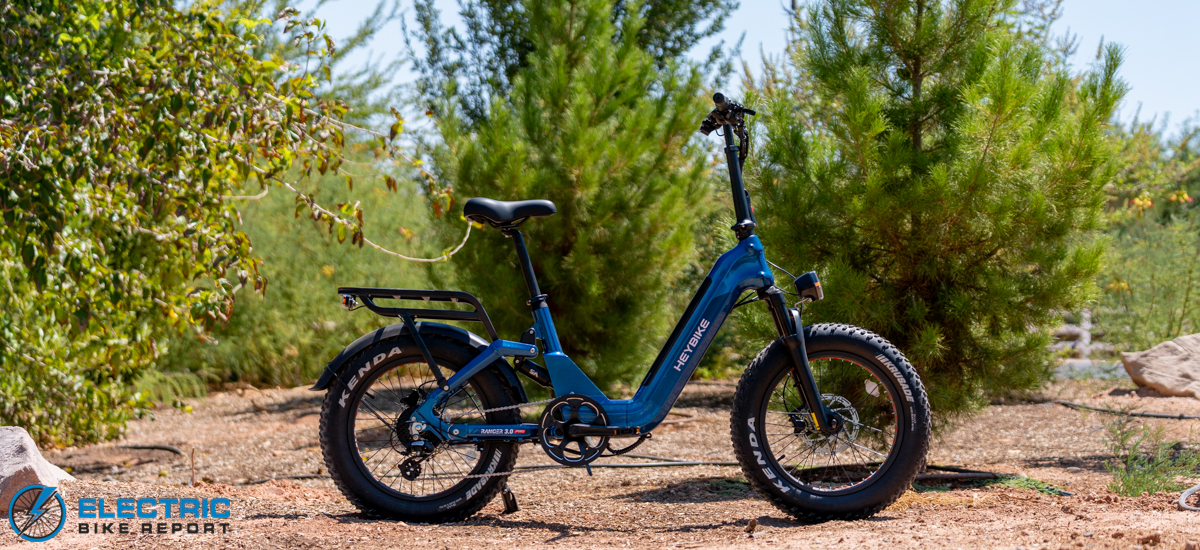
As e-bike brands grow and evolve, we expect that their new models will reflect this development. The Ranger 3.0 Pro, like its sibling in Heybike’s X-Series of fat tire folding e-bikes, the Mars 3.0, is an excellent example of the brand’s progress.
Not only does the bike look sharper while maintaining a similar aesthetic to the last-gen Ranger S, it’s better equipped with features that, at least in theory, should improve its overall performance, comfort level, and overall ride feel.
One of the bike’s most obvious upgrades is its rear suspension. Previously reserved for the Horizon, a costlier, duo-tone version of the old Ranger S, Heybike has merged the two aging models to create a refreshed, visually appealing, and affordably-priced folding e-bike with a smooth ride and a long list of impressive specs.
For example, the bike boasts a 750W hub motor that can propel it up to 28 mph and a 48V, 720 watt-hour (Wh) battery with an estimated range of up to 90 miles. It’s also loaded with hydraulic disc brakes with uncommonly-thick 2.3mm rotors, an 8-speed drivetrain, and a cargo rack that can carry up to 100 lbs.
Some of the bike’s most attractive features include a torque sensor, which allows its motor to adapt its power output to how the rider pedals, Bluetooth connectivity that allows it to pair with the Heybike app, and front and rear turn signals for added safety. At the time of writing, it’s also available in a limited edition Miami Vice-inspired tri-color paint job.
But how does the bike perform in the real world? That’s the question we set out to answer in this review. After all, even the best list of specs and features doesn’t mean that a bike is practical or enjoyable to ride.
We were impressed with the Ranger 3.0 Pro on paper, but we tested its range, climbing power, braking performance, and speed to determine if it’s worth your purchase, or if you’d be better off with another of the dozens of similar e-bikes on the market. See our full review below to find our verdict.
Class 2 (throttle to 20 mph)
Class 3 (pedal assist to 28 mph)
 Pros
Pros- The Ranger delivers a responsive yet easy pedal experience, thanks to its powerful 750W motor and combination of torque and cadence sensors.
- Its ride is both stable and super comfortable as a result of its full suspension and 20×4” fat tires.
- Users can customize their speed, throttle behavior, acceleration force, and pedal responsiveness through the display menu and Heybike app.
- It delivers a lot of value for its $1500 price, with a spec package that includes
- This bike is accommodating! It fits riders from 4’11” to 6’2” and can carry up to 440 lbs (with up to 100 lbs on the rear cargo rack).
- It’s UL 2849 certified and has a battery built to UL 2271 standards. Its electrical components bear an IP65 water resistant rating, and the bike itself is rated to IPX5.
- The Ranger’s step-thru frame has a standover height of just 14.5”, making it easy to hop on and ride.
- We liked the Ranger’s sharp new look, which includes three flashy colors, including Ruby Red, Sapphire Blue, and Emerald Green.
 Cons
Cons- With a weight of roughly 77 lbs (including its removable 8-lb battery), the Ranger 3.0 Pro may be difficult for riders seeking a portable e-bike to lift and move regularly.
- Increasing the bike’s pedal-assisted speed above 20 mph also raises its throttle speed. We’d prefer the ability to adjust both independently.
- Battery:48V, 720 Wh, Meets UL 2271 Standards
- Display: TFT Display&NFC Start-up
- Motor: 750W (sustained), 1200W (peak), 80 Nm torque
- Headlight: Frontlight with Horn
- Taillights:Taillight with Brake & Turn Signals
- Pedal Assist: 5 Assist Levels, Torque Sensor
- Claimed Range: 90 miles
- Throttle:Half-Twist
- App:Heybike App
- UL Certification: UL 2849 Certified
- Claimed weight: 75 lbs
- Tested Weight: 76.7 lbs
- Rider height range: 4’11” – 6’2″
- Total payload capacity: 440 lbs
- Brakes:Hydraulic Disc Brakes, 180mm x 2.3mm Rotors
- Fenders:Included
- Fork:Hydraulic Front Suspension Fork, 65mm Travel
- Shock:Adjustable Air Shock, Up to 174 PSI
- Frame: 6061 Aluminum Alloy Frame
- Drivetrain:Shimano Altus 8 speed, 48T Chainring, 13-32T Cassette
- Grips: Rubber
- Saddle: Custom
- Handlebar: 630mm
- Kickstand: Alloy
- Pedals: Folding Plastic
- Tires: Puncture protection, Kenda 20″x4.0″ fat tires
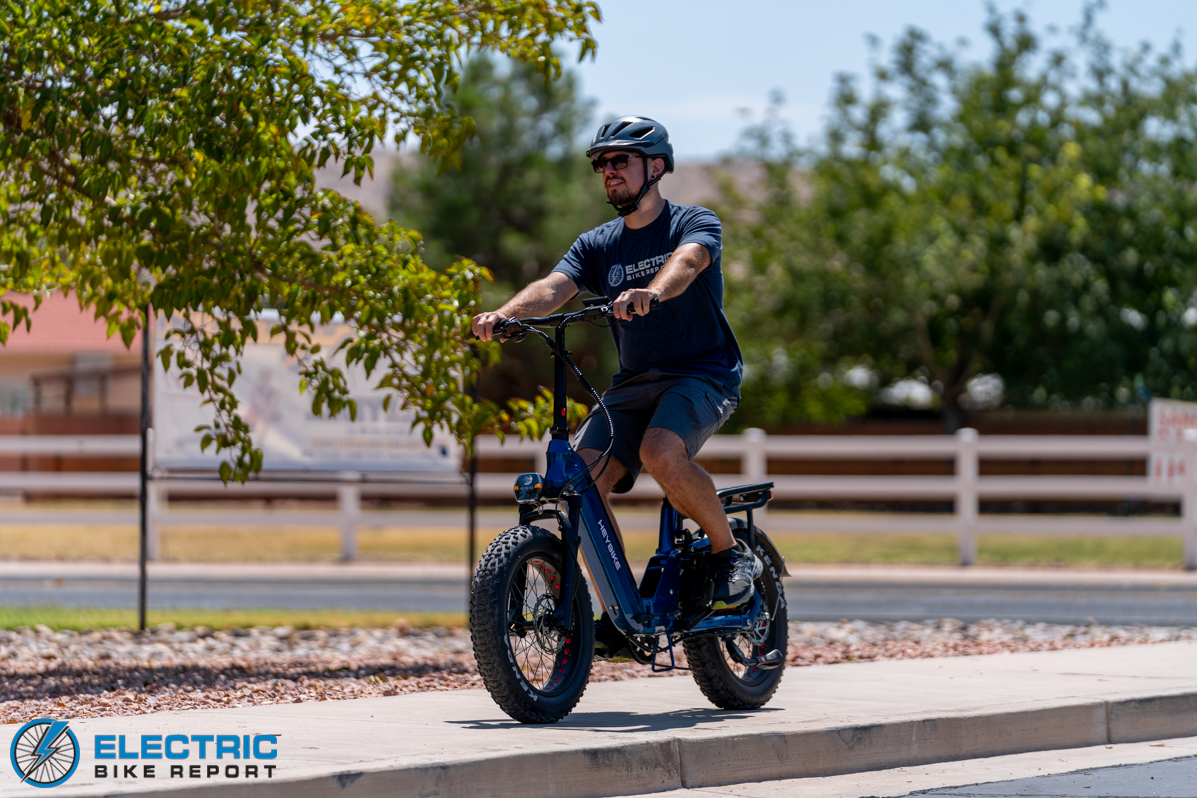
Heybike ships the Ranger 3.0 Pro as a Class 2 e-bike with throttle and pedal assist up to 20 mph, but it can be unlocked to Class 3 speeds through the brand’s app.

The rear suspension features an adjustable air shock that can be tailored to the rider’s weight and comfort preference.
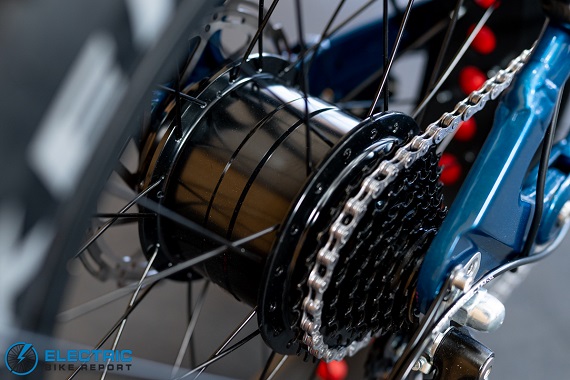
The Ranger has a 750W hub motor paired with a torque sensor for a responsive and engaging feel when pedaling.
Heybike Ranger 3.0 Pro Review: Speed Test
To learn how fast the Ranger 3.0 could be, and to understand its programming, I tested the bike on a paved shared-use trail local to our area in Southwestern Utah. I rode it in both its Class 2 and Class 3 modes, keeping track of my average speeds in each of the bike’s five pedal assist system (PAS) settings; see the graph above for both sets of test results.
As mentioned previously, the Ranger 3.0 has a torque sensor that allows its motor to adapt its power output in response to how its rider pedals. What I didn’t mention, however, is that the bike has five preset speed limits dictated by the PAS, so its 750W motor delivers power responsively up to those speeds.
The preset limits (as shown in the Heybike app) are as follows:
- Eco – 10 mph (Class 2), 15 mph (Class 3)
- Tour – 13 mph (Class 2), 18 mph (Class 3)
- Standard – 15 mph (Class 2), 22 mph (Class 3)
- Sport – 18 mph (Class 2), 25 mph (Class 3)
- Turbo – 20 mph (Class 2), 28 mph (Class 3)
As the graph above shows, the bike’s actual speeds were close to the programmed limits, but in many cases, differed by roughly 0.5 mph. In both tests, the increases in speed and power between PAS settings felt as incremental and measured as the graphs’ linear patterns show.
The bike’s speeds are also customizable using a system of sliders within the Heybike app; these include the bike’s maximum speed as well as individual adjustments for all five of its PAS settings. When adjusting the Ranger 3.0’s overall maximum speed, the sliders automatically adjust to redistribute the individual limits of its PAS.
Especially when riding in the bike’s higher power levels (PAS 4 or 5), I noticed that I didn’t have to press into the pedals for the motor to carry me along at speed. This suggests that the Ranger employs both a torque and cadence sensor, allowing the motor’s output to respond when riders pedal actively, but also allowing it to provide plenty of power and speed when the rider simply turns the cranks casually.
A point of critique arose during my test of the Ranger 3.0 Pro’s throttle. In most places in the US, throttle speed is legally required to stop at 20 mph, but adjusting the Ranger’s maximum pedal-assisted speed above 20 mph also increased its throttle speed.
Considering that this can technically make it an Unclassified e-bike that may require registration to be ridden in some areas, we encourage Heybike to allow independent control over the maximum throttle and pedal-assisted speed limits.
Otherwise, I liked that riders have the option to allow the throttle to reach the bike’s maximum speed in all PAS settings or restrict it to the same five speed limits applied to the pedal assist system.
I also appreciated the throttle’s overall behavior; it started gradually so as not to feel scary or out of control. Once I was moving, it picked up speed swiftly and carried me up to maximum speed in a matter of seconds.
When pedaling the bike, I appreciated its responsive power delivery, though personally, I prefer the ability to pedal up to the bike’s maximum speed in all PAS levels. The Ranger’s customization options work for those such as myself, too; I could adjust all of its sliders to 20 or 28 mph and pedal with different power levels, though this removed the ability to have different speed limits for the throttle.
One relatively minor point of critique aside, the Ranger 3.0 Pro performed very well in this test. We liked its programming, customization options, and overall distribution of power levels. It balances approachability and power so as to be capable without feeling out of control.
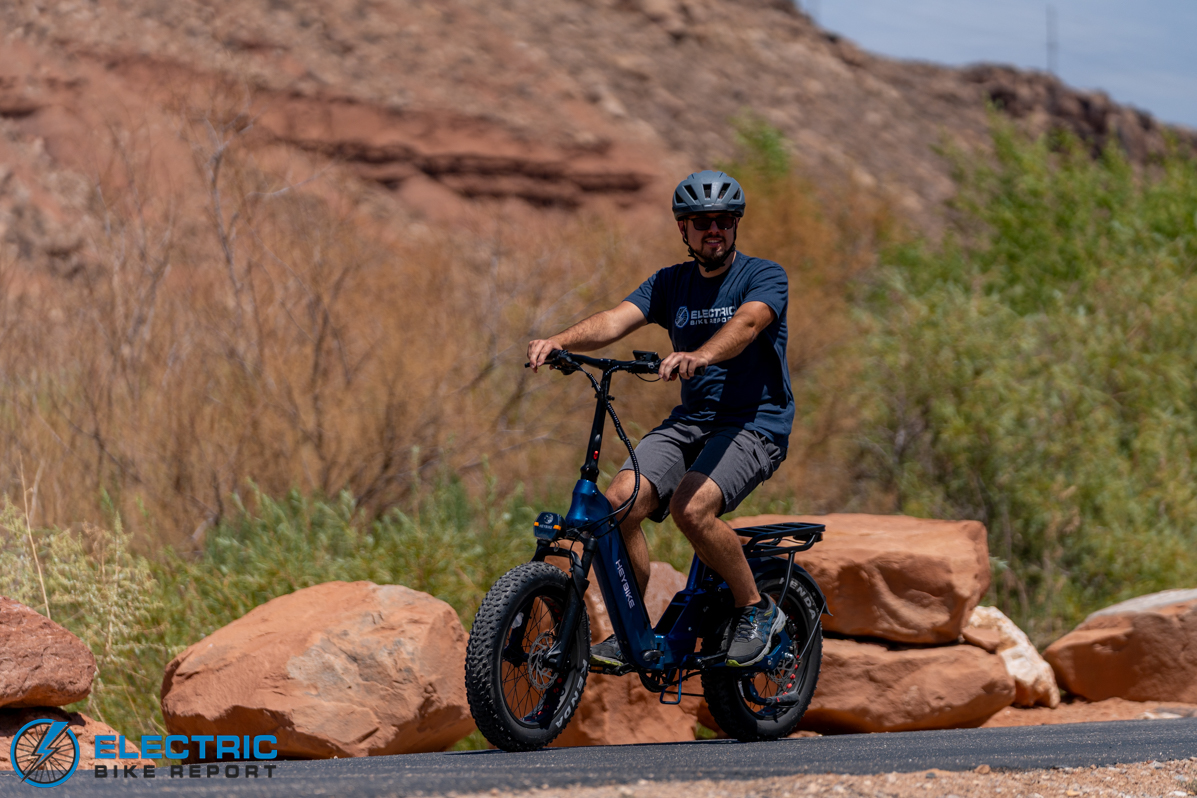
We found the bike suitable for leisure rides, errand running, commuting, and exploring both paved or unpaved paths/roads.
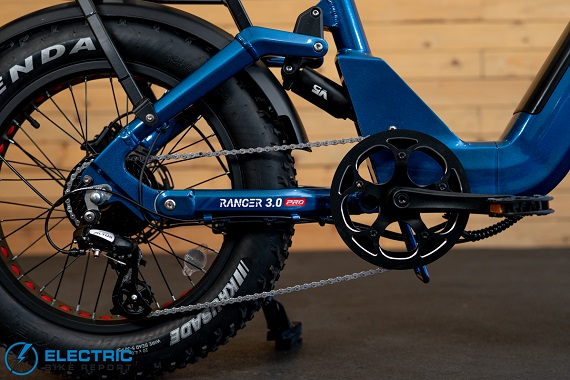
An 8-speed Shimano Altus drivetrain is an upgrade from the previous model’s 7-speed drivetrain.
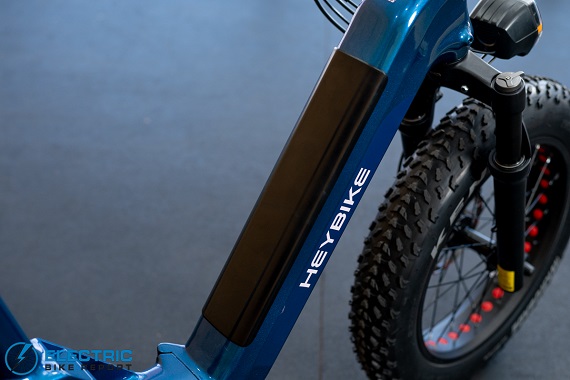
The bike’s 48V, 720 Wh battery is built to UL 2271 standards and can be removed for charging or transport.
Heybike Ranger 3.0 Pro Review: Range Test
We tested the Ranger 3.0 Pro’s range in two tests using the method explained above. Heybike advertises up to 90 miles of range from the bike’s 48V, 720 Wh battery. Our tests showed this estimate to be quite hopeful, though the Ranger’s results lined up much closer with those of many of its peers.
A group of similar folding e-bikes we tested previously, including the last-gen Heybike Ranger S, averaged a minimum range of 29.6 miles and a maximum range of 59.9 miles in our testing. The Ranger 3.0 Pro was slightly below average in both tests, differing by roughly 4 miles in its Turbo test and about 9 miles in its Eco test.
No clear single reason stood out as to why the Ranger fell somewhat below average in this test, so I believe its results may be due to a combination of factors, including its weight and motor output.
The Ranger 3.0 Pro weighs roughly 77 lbs and its motor can produce a maximum of 1200W of peak power, while the bikes we used for comparison, on average, weighed less and had less powerful motors (70 lbs and a peak of 996W). As such, the Ranger was at somewhat of a disadvantage; its motor could naturally use more power to start, while its higher weight required even more to get moving or climb hills.
It’s worth noting that the bike’s 720Wh battery was larger than average (663 Wh), but it seems that other factors canceled out the benefit of a relatively high-capacity power source.
Regardless of the cause, we can divide the bike’s battery capacity by its range to find the number of watt hours its motor used per mile. While the other bikes we used for comparison averaged a relatively efficient 11.1 and 22.4 Wh/mi in their low-power and max-PAS range tests, respectively, the Ranger 3.0 Pro was noticeably less efficient; it used 14.1 and 27.9 Wh/mi.
To be clear, the Ranger’s test results still make for a practical ride! Those willing to ride slower will clearly be able to get more distance from a single charge, but even the bike’s high-power test results show it should handle multiple round-trip commutes or leisure rides for most users.
Potential buyers should keep in mind that our testing was performed using the bike’s Class 2 settings, so those opening up the motor to Class 3 mode should expect fewer miles. When needing to recharge, however, the included 2-amp charger should refill the 15 amp-hour (Ah) battery in roughly 7.5 hours.
Heybike Ranger 3.0 Pro Review: Hill Test
The Ranger 3.0 Pro proved to be a competent and capable climber in our Hill Test! We evaluated the bike using the method explained above. Its throttle result of 2:00 was slightly slower than a group of similar folding e-bikes, but its pedal time of 1:47 was noticeably faster than its competitors; the models used for comparison averaged 1:55 and 1:56.
Once again, weight and motor power are likely two factors that likely contributed the most to the Ranger’s performance, though I believe its programming also came into play. The bike’s peak motor output of 1200W and 80 Nm of torque is higher than average (996W and 69 Nm), which is particularly noticeable in its above-average pedal test.
Similarly, the Ranger’s 77-lb weight is above the 70-lb average. This seems to have held the bike back somewhat in the throttle test, though its pedal time would also likely have been faster had it weighed less.
As mentioned in the Speed Test section above, the Ranger’s throttle felt steady and strong without being too punchy. In my experience, it felt capable on hills, though it was noticeably slower than when I chose to pedal. The Ranger 3.0 required active pedaling when I did not use the throttle, so my pedaling felt engaged but not strenuous.
Considering that my personal experience matched the Ranger 3.0 Pro’s test scores, we can state that the bike is powerful enough to allow most users to throttle or pedal over most hills. Those who prefer the fastest experience may need to contribute some effort on the pedals, but should not expect to work up a sweat while doing so.

Heybike offers the Ranger 3.0 in Sapphire Blue (pictured), Ruby Red, and Emerald Green.
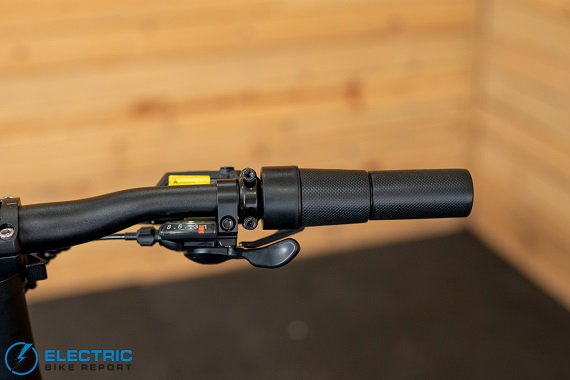
A half-twist throttle on the right handlebar is comfortable and easy to use.
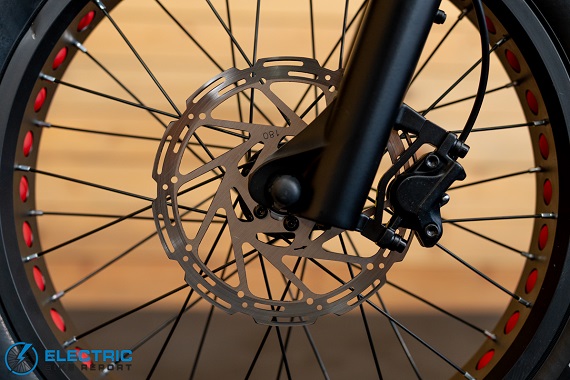
The Ranger’s brakes use 2.3mm-thick rotors that dissipate heat better than the standard 1.8mm-thick discs.
Heybike Ranger 3.0 Pro Review: Brake Test

Considering that Heybike specifically advertises a high-quality and high-performance brakes system on the Ranger 3.0 Pro, I was especially curious to see how the bike would fare in our Brake Test.
We used the method above to determine its average stopping distance of 20’ 7”. A pool of similar models that included a couple of overperforming e-bikes averaged 19’ 4”, but with those models removed from our comparison group, the category average fell to 20′ 3”. As such, we can say that the Ranger’s braking performance was relatively average for its style.
Based on my personal experience, I’m surprised that its test score was not shorter.
Braking on the Ranger 3.0 Pro felt relatively sudden and intense, but in a way that felt confidence-inspiring and appropriate instead of unsafe. Even when cruising at Class 3 speeds (or even faster when riding downhill), the bike’s brake system modulated speed well without much fade—a direct result of their thicker-than-average 180×2.3mm rotors.
While the bike’s brakes are unbranded, the brake lever bodies resemble those made by Tektro. As such, it is possible that they are manufactured by one of the largest and most reputable brake brands, though we have no way to verify this.
Regardless, based on their feel and performance, we can safely and confidently say that the Ranger 3.0 Pro is equipped with powerful, effective brakes.
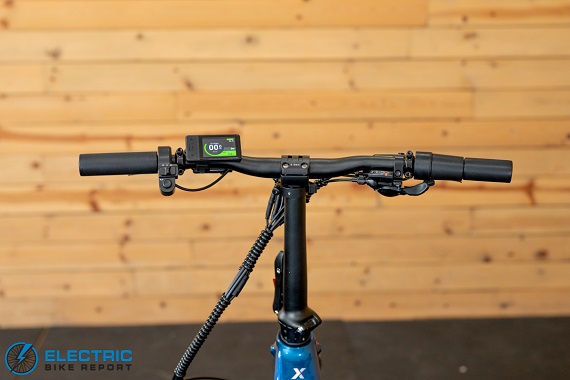
Riders can adjust the handlebar height by up to 5.5” using the telescoping/collapsible stem.

The Ranger’s front suspension uses a coil spring that offers 65mm of travel.

Like most folding e-bikes, the Ranger’s frame has a hinge that secures both halves together while also allowing it to separate when needed.
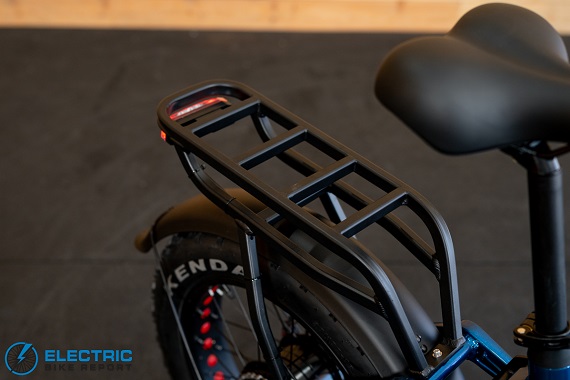
Heybike advertises that the Ranger’s rear cargo rack can support up to 100 lbs. It’s compatible with a cargo basket, panniers, and even a soft pet carrier.
Heybike Ranger 3.0 Pro Review: Ride Quality
This ride quality section is primarily an attempt to describe how the Ranger 3.0 Pro feels to ride, though some other elements of its operation are also points of focus.
Starting with sizing, Heybike manufactures a single frame size with a telescoping stem and accommodating seatpost, allowing the bike to fit riders between 4’11” and 6’2”. My height of 5’11” places me near the top of the recommended height range; I found the bike generally comfortable, but there were a few aspects I think buyers should be aware of.
First, though I rode with the saddle at its maximum height (the seatpost offers 7.5” of adjustment), I was not able to reach full leg extension. As such, my pedaling wasn’t as efficient as it could have been, but I appreciate that the PAS was powerful and sensitive enough to deliver ample power without requiring much effort or strain.
As with many folding e-bikes, the Ranger 3.0’s reach is long, requiring my arms to be almost completely outstretched. The telescoping stem offers roughly 5.5” of adjustment in handlebar height, though the bike’s reach adjustment is limited to the rails on the saddle.
We’ve seen popular brands like Lectric adopt a zero-degree stem (its angle matches the bike’s head tube) for a more comfortable fit; we wouldn’t mind seeing Heybike and other brands adopt the same approach for the sake of ergonomics.
Otherwise, the bike’s mostly upright riding position felt comfortable, and I liked its saddle and grips. The ride was also kept smooth and comfortable by the full suspension and fat tires. It was great to see an adjustable air shock! Its stock pressure was somewhat stiff for my size and weight, but the setup allows riders to tailor its feel to their body and personal preferences.
The bike was expectedly nimble and quick in its handling; this is another common element of folding e-bikes with 20” wheels, relatively narrow handlebars, and telescoping stems. Many similar folding e-bikes have adopted smaller tires, but I appreciated that the Ranger’s 4-inch tires maximized riding and cornering stability (despite adding some weight).
I’ve discussed the motor’s engagement and feel in the Speed Test section, but I’ll reiterate that I enjoyed its power, responsiveness, and customization features. While I didn’t mind, I found the motor to be somewhat loud; it sounded more like a jet preparing for takeoff than I’m used to in its highest power level.
The Heybike app gives users control over the Ranger’s speed, acceleration force, responsiveness, throttle behavior, and the number of pedal assist settings. It’s also possible for the bike to reach speeds in excess of 30 mph when fully unlocked through both the Heybike app and display.
Speaking of the display, this is one of the most noticeable and impactful upgrades on this version of the Ranger. The full-color TFT display is well-organized and pretty to look at, as well as color-coded in each PAS level for ease of use. It also boasts a security feature that requires either a keycard or 4-digit PIN to be entered upon startup, though users turning the bike on through the app can bypass this.
As a folding e-bike, the Ranger 3.0 Pro generally succeeds, with relatively standard folding mechanisms and a tried-and-tested design. The redesigned, beefed-up frame and rear suspension increased its overall weight, however; potential buyers seeking a highly portable e-bike they plan to fold and move regularly may be turned off by the 77-lb weight.
The folding process itself is relatively straightforward, as are the bike’s folding mechanisms. Like many similar models, the Ranger has a central locking hinge built into the frame, along with folding pedals and a collapsible stem.
I noticed that the front brake line acted as sort of a buffer between the fork and chain stay when folded; this protected the frame but may have the potential to cause pinching. A rubber bumper added to the frame would likely present a better solution. Once folded, we measured the Ranger 3.0 Pro at roughly 35”L x 21.5”W x 32”H.
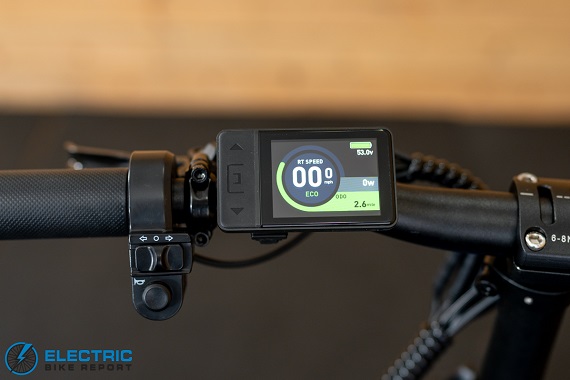
The combination display/control panel is color-coded by PAS level and generally easy to read.
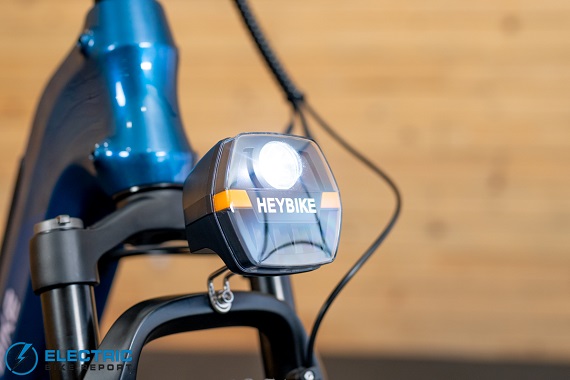
A headlight that includes front turn signals is a rare sight! We liked the extra layer of visibility and communication.
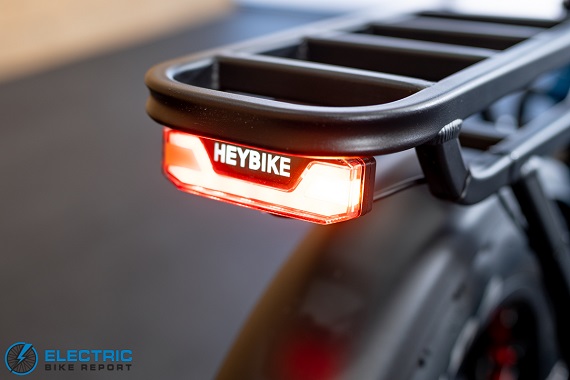
The bike’s tail light includes turn signals and functions as a brake light when the levers are squeezed.
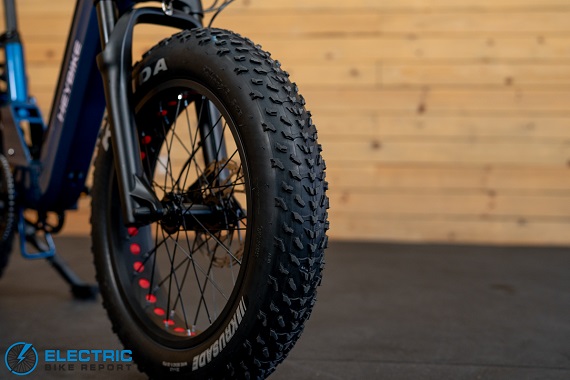
Knobby 20×4” fat tires offer comfort, stability, and plenty of grip on dirt and gravel roads.
Heybike Ranger 3.0 Pro Review: Summary / Where to Buy
After previously reviewing the last-gen Ranger, I can confidently say that the Ranger 3.0 Pro is an upgrade in most areas. One of the biggest improvements over the previous model is the bike’s motor engagement and responsiveness; where the Ranger S’s motor felt somewhat delayed, the 3.0 Pro’s torque sensor ensures rapid and adaptive power delivery.
Another area where the Ranger 3.0 stands out is its comfort factor. The rear suspension adds weight, but it also makes for a much smoother and more enjoyable ride. The list of upgrades doesn’t stop there, however; nearly everything from the drivetrain and brakes to the user interface and overall aesthetic reflect a better-equipped and more thoughtfully assembled e-bike.
The Ranger 3.0 Pro scored generally well in all areas of our testing, with range, braking performance, and climbing ability that closely matches the results of many of its peers. It also demonstrated the ability to reach Class 2 and Class 3 speeds effectively with intuitive default programming and plenty of customization options for those with different preferences.
Our main areas of critique focused on the bike’s overall weight of over 75 lbs and the inability to adjust throttle and pedal-assisted speeds individually. The former makes the bike somewhat difficult to lift and carry, while the latter can result in the bike exceeding legal throttle limits in many locations.
Critique aside, the Ranger 3.0 Pro has many appealing features that would make it practical for leisure, daily commuting or errand running, and both on- and off-road adventuring. With app integration, a long list of solid specs, and a full suspension, it’s a sharp-looking and affordably-priced e-bike offering lots of bang for the buck.
Happy Riding! Make sure to let us know if you have any questions or if you think we left anything out in this review of the Heybike Ranger 3.0 Pro down in our comments section.



